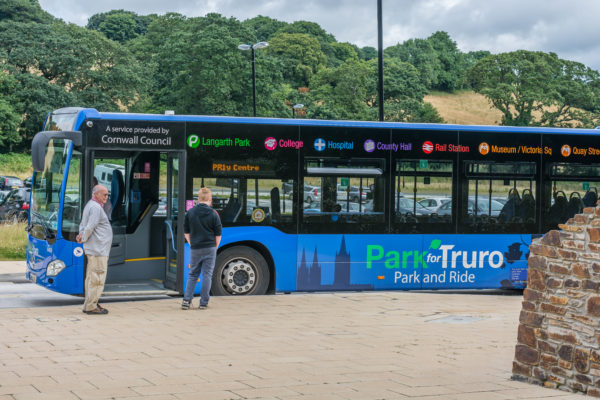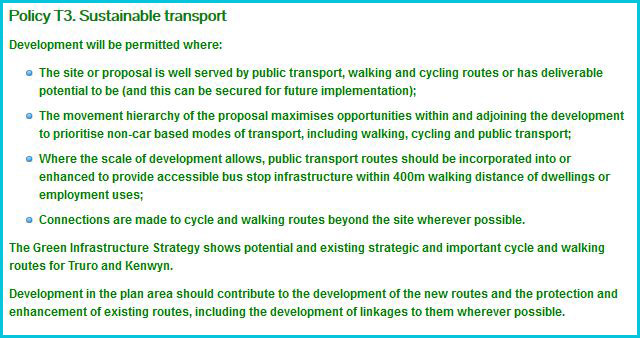Transport in Truro and Kenwyn:
Truro lies on the mainline railway from Penzance to London Paddington and has a frequent service to other towns.
The A30 runs along the boundary of Kenwyn Parish, but access to the city is via the A39 and the A390, which run through the city centre before splitting to take the A39 to Falmouth and A390 through the Highertown and Threemilestone areas.
Bus services in the Plan area vary in frequency but many inter urban routes run through the city. Bus services on the A390 corridor are very frequent (up to one bus every 4 minutes during the day), whilst access on the B3284 through Kenwyn and Shortlanesend is poor. Significant parts of the Kenwyn parish area (excluding Threemilestone and Gloweth) are rural in nature and have little or no access to bus services.
There are extensive networks of paths and other access routes (including for instance the Coosebean and Newham cycle-ways) around the historic areas of the city and the rural areas of Kenwyn parish, but the Threemilestone and Highertown areas are less well served.
The highway network in Truro and Kenwyn is often congested and at times reaches or exceeds capacity, although outside of beginning and end of the working day there is considerably less traffic using the network. There is an air quality issue on the A390 at Highertown.
The bus service in Truro is adequate although in Kenwyn it needs vastly improving in terms of routes and frequency.
There is an extensive walking and cycle network in the area, although some of the older areas are less well maintained. New access ways and areas should be opened up to increase the usage of sustainable transport.
What does the plan propose for transport?
-
Safeguarding future transport opportunities:
There is potential for re-opening or creating new halts in the Plan area and these sites will be safeguarded with an allocation for sites that will be deliverable and required within the Plan period for providing new or improved sustainable transport or freight uses. The Port of Truro should be enhanced, subject to consideration of the Special Area of Conservation that it lies within.
The Neighbourhood Plan supports work outside of the Plan area towards reopening the Parkandillick branch to Newquay and the possibility of a cross country link for Falmouth, Truro, St Austell and Newquay.
-
Active Travel and accessibility:
Opportunities for new trails and improvements to existing crossings and routes for walking and cycling have been considered and identified in the Plan. Standards for new development have been set that include consideration of active travel, accessibility to public transport, mixed uses and access to recreation and other high volume uses. Other actions to increase active travel will be incorporated into the Truro and Kenwyn Green Infrastructure Strategy;
-
Bus and taxi access:
More buses are required and a local bus route around the city centre (like Falmouth) and also increased access to industrial estates and employment areas. For new developments, a 300/400 metre standard should be applied for bus stops.
Taxis also provide a valuable service for people wishing to access the city centre. Licenced cabs have increased in numbers over the past decade, but the number of taxi ranks have failed to keep check. The City Council supports exploration of options for new ranks to be provided over the Plan period.
-
Reducing the need to travel:
Measures that help to reduce the need to travel will be encouraged, including remote and home working opportunities. Mixed use developments as well as intensification of uses in the city centre can help reduce the need to travel.
Transport policies
T1. Truro and Kenwyn Transport Strategy Contributions
Efficient, low-cost and low-carbon transportation is essential for the sustainability and prosperity of the local area. People need to get to work quickly and affordably and this can be delivered through efficient public transport networks linking the area together. Cycling and walking routes will help to reduce demand on local services and help maintain the health of the local community.
It is therefore important that opportunities to enhance existing, or develop new infrastructure be built into new developments with strong transport links effectively incorporated into the design. Coupling the construction of buildings and infrastructure will reduce the cost of construction and also allow the community to grow together and more harmoniously.
T2. Safeguarding Railway land
Increasing the capacity of the rail network is done most efficiently by using existing resources. Disused parts of the rail network must be retained by ensuring that new construction does not obstruct any future plans for the expansion of one of our most sustainable forms of public transport. Growth of the community can be achieved more efficiently if we plan in room for expansion of necessary infrastructure saving valuable resources.

T3. Sustainable transport prioritisation
A large part of reducing traffic congestion can be achieved by encouraging easy access to sustainable transport measures. In new development, this can be helped by designing layouts to prioritise cycling, walking and bus use. Capitalising on existing infrastructure is important to keep cost and environmental impact down but also helps enhance the speed of delivering a well-connected travel infrastructure. This policy aims to create a sustainable future for transport and will ensure that development is well served by non-car transportation options.
Other mechanisms will help to change travel behaviour over the Plan period. This includes completion and delivery of the Truro and Kenwyn Green Infrastructure Strategy to establish accessibility and active travel proposals. This will help to identify and plan projects to improve accessibility in the Plan area.
Sustainability
These policies aim to contribute to sustainable development by:
- Reducing the need to travel
- Encouraging new mixed use developments
- Prioritising the use of sustainable transport measures
- Encouraging active travel
National Planning Policy Framework (NPPF):
NPPF4: Promoting sustainable transport;
NPPF7: Requiring good design;
NPPF8: Promoting healthy communities
NPPF10: Meeting the challenge of climate change, flooding and coastal change
Cornwall Local Plan:
1: Sustainable development
12: Design
13: Development Standards
21: Best use of land and existing buildings
25: Green Infrastructure
27: Transport and accessibility
Who will assist with delivering the aims of transport policy?
- Cornwall Council (particularly Transportation);
- Bus and train operating companies
- Private Sector providers/businesses;
- Network Rail;
- Land owners and developers.







